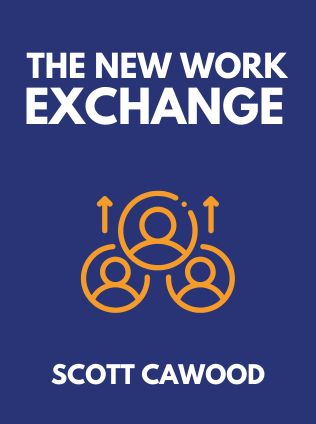
The New Work Exchange
Embracing the Future by Putting Employees First
By Scott Cawood
Published 06/2023
About the Author
Scott Cawood is a renowned thought leader in the field of organizational culture and human resources. With a rich background that spans several decades, Cawood has held leadership positions in a variety of industries, making significant contributions to the way companies view and engage with their employees. His work is characterized by a deep commitment to putting people at the center of business strategy, believing that the key to organizational success lies in the well-being and engagement of its workforce. In "The New Work Exchange: Embracing the Future by Putting Employees First," Cawood draws from his extensive experience to offer a transformative perspective on the future of work.
Main Idea
"The New Work Exchange: Embracing the Future by Putting Employees First" by Scott Cawood is a clarion call for organizations to redefine their approach to work and workplace culture. The book argues that the traditional paradigms of employment are outdated and no longer serve the needs of modern employees or businesses. Cawood advocates for a new model of work that prioritizes people, fosters a culture of engagement, and aligns organizational values with those of its employees. This book is not just a critique of the current state of work but a blueprint for building a better, more humane workplace that benefits both individuals and organizations.
Table of Contents
- Introduction: The State of Work
- Chapter 1: Working for Way More Than the Weekend
- Chapter 2: Looking Back and Moving Forward
- Chapter 3: Walking Away from Obsolete Practices
- Chapter 4: Putting People First
- Chapter 5: Fostering Stakeholders
- Chapter 6: Finding Our Pace in a Much Faster World
- Conclusion: Exchanging Old for New
Introduction: The State of Work
In the introduction, Cawood sets the stage by highlighting the current dissatisfaction many people feel towards their work. He cites a Gallup report indicating that 60% of people feel "detached at work," while 10% are "miserable." These statistics serve as a stark reminder that something is fundamentally wrong with how work is structured today. Cawood proposes that a new era of work, the New Work Exchange, is emerging. This new paradigm seeks to align the needs and aspirations of employees with the goals of their organizations, fostering a more engaged and fulfilled workforce.
Chapter 1: Working for Way More Than the Weekend
In the first chapter, Cawood explores the evolving nature of work. He argues that the traditional nine-to-five, paycheck-driven model is increasingly irrelevant in today's world. Instead, people are seeking meaning and alignment between their personal values and their work. Cawood states:
"Work isn't just about monetary compensation or the physical workplace. It's about the value alignment between employer and employee." - Scott Cawood
To illustrate this point, Cawood provides examples of companies that have successfully created a culture where employees feel valued and engaged. These companies understand that a healthy work culture is not just about policies and processes but about creating an environment where people can thrive. For example, a company might:
- Offer flexible work arrangements to accommodate different lifestyles.
- Encourage employee participation in decision-making processes.
- Provide opportunities for professional growth and development.
Ultimately, organizations are trying to find people who care about their work, and people are trying to find organizations that care about them and support what’s important to them. Positively redefining your work and workplace demands forging an alignment between your organization and its people. Understand that work can be different and better. Don’t be averse to disruption. Instead, acknowledge how change can make things better. Divorce yourself from outdated systems of work and transform work into something more meaningful for the people within your organization.
Acknowledge that people are the core of your business. Create a work culture where people become your business. When we see people as our business, it allows us to shift the conversation and focus on what it takes for people to do their best work. Create a healthy culture that sets people up for success. Culture is about how things get done in an organization. It manifests as policies, processes, mindsets, interactions, and decisions.
Chapter 2: Looking Back and Moving Forward
Cawood takes a historical perspective in this chapter, tracing the evolution of work from the Industrial Revolution to the present day. He examines how the structures and norms established during this period have shaped our current understanding of work. However, he argues that these old models are no longer sufficient. He shares the story of W.L. Gore & Associates, a company known for its non-hierarchical, team-based approach. Cawood highlights how this company’s model, which emphasizes freedom, commitment, fairness, and a sense of shared responsibility, has created a more engaged and productive workforce.
The Industrial Revolution came with manufacturing environments like factories, which provided an employment outlet that was revolutionary for millions. Railroads brought another hiring boom and brought along the corporate hierarchy that we’re all familiar with today.
Sign up for FREE and get access to 1,400+ books summaries.
You May Also Like
The Subtle Art of Not Giving a F*ck
A Counterintuitive Approach to Living a Good Life
By Mark MansonRich Dad Poor Dad
What the Rich Teach Their Kids About Money - That the Poor and Middle Class Do Not!
By Robert T. KiyosakiHow To Win Friends and Influence People
The All-Time Classic Manual Of People Skills
By Dale CarnegieQuiet: The Power of Introverts
The Power of Introverts in a World That Can't Stop Talking
By Susan Cain



















